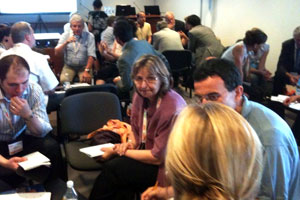Businesses need new knowledge in order to innovate, develop and become successful. But how should these new ideas be obtained and by whom? These were the key questions discussed at an interactive seminar, organised by the Swedish association VA (Public & Science) on July 5 as part of 2010 EuroScience Open Forum in Turin, Italy.

Nearly 40 percent of all business leaders interviewed in a recent Swedish survey believe that postgraduates are too specialized to fit into their businesses. This and more selected results from VA’s study on the value of knowledge in the business world were presented by Ki Andersson, Senior Analyst, VA (Public & Science). In the study, attitudes towards science and knowledge among 600 business leaders were surveyed.
We need to make the market for services far more buoyant, flexible and effective in our European context, said Malcolm Harbour, Member of the European Parliament, representing the UK. He has been involved in the work on developing the Directive on services in the internal market, for the past five years. The Directive, initiated by the European Commission, aims at creating a single market for services within the European Union, by requiring all European countries to map and examine barriers in national legislation as well as at operational levels and in the delivery of services. As a result, more than 16.000 different individual barriers have been identified.
There has been far too much attention in Europe, pushing the technology out to the industry and not enough concern on how to create the right environment in which the industry wants to use it, said Richard Hudson, CEO and editor of the UK based Science Business Publishing Ltd.
Nikola Macharová, PhD candidate in cultural Management at the University of Constantine, Slovakia, shared an experience she made a few years back. When working in a water management company she repeatedly failed to establish collaboration with the local university. She wants to see academia and business closer and much more interlinked. The gap is present, but the question is what can be done?
After the first presentations, all participants were invited to discuss in small groups whether academic research is underused and undervalued by business or not, and if there is a gap between business and academia.
When reporting back one group said: There is definitely a gap. Both sides have their interests. You have to come up with an agreement, and because of cultural differences, transfer of knowledge to business takes time. Another group agreed on the challenges of cultural differences: How deep are businesses prepared to allow researchers into their businesses?
After a short break, another set of results from the VA study was presented, focusing on the distinct differences in attitudes towards science and technology between business leaders in traditional manufacturing industries and those more negative in the service sector.
Mary Walshok, Professor in Sociology at UC San Diego, US, referred to statistics showing that 93 percent of new jobs originate in companies that are not more than five years old. We should create new companies and new jobs, and not just serve the old ones. What is needed is to engage small companies to stay in business. Sometimes simply connecting diverse ideas could be enough, Professor Walshok stated.
Involve the industry in the right way! Allan Simpson, Managing Director, PlayVision AB, Sweden, exclaimed. With a combined background in academia and strategic business management, he argued that the gap between the two exists because 1: the priorities, the focus, the goals and the objectives are totally different 2: most of the stuff that comes out of university researchers is useless. According to Mr Simpson, small companies and academia both are innovative. Innovation is a new way to solve a problem. That means change, and big businesses don’t like that.
Francesco Lovo, Research and Development Director, Pininfarina Extra Sr, Italy, talked about the value of collaboration, not only between academia and business, but also between industrial academics. Design today is more designing an experience than a product, paying attention to cultural differences.
The roundtable groups were invited to discuss what should be done to bridge the gap identified and who should do it. Some opinions expressed in the subsequent plenary discussion were:
* Universities should have a screening program – quality not quantity.
* Researchers need to work with businesses early on in their careers.
* There has to be good networking, because ideas can come through in different ways.
* We have to listen to what is happening and be adaptive to different solutions.
* While a company may have a point, technology is the one that exchanges ideas.
Before closing the session, the moderators, Camilla Modéer, Secretary General of VA (Public & Science) and Carl Johan Sundberg, Researcher at the Karolinska Institutet, Sweden and one of the founders of ESOF, invited the speakers to summarize their single most important take-home message:
* All research students should have some elements of work with entrepreneurship in their training. Malcolm Harbour
* Don’t sell technology, instead encourage the market to buy it. Richard Hudson
* Open the gates of business for research candidates and students and they will believe that collaboration is possible. Nikola Macharová
* First experience, product second. Francesco Lovo
* Make sure that R (Research) in academia is available for the big companies but that the R is paid for when the product is being sold. Allan Simpson
* Universities need to develop comprehensive strategies at student level, at R (Research) level, at D (Development) level and at mentorship level. And the scientists have to start working with law schools and other schools and across disciplines. Mary Walshok
Report: Shigufta Syed and Ki Andersson
